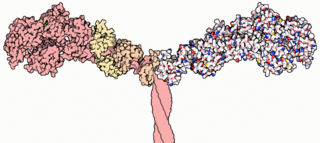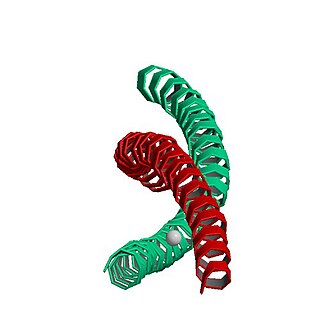Myosin-11 is a protein that in humans is encoded by the MYH11 gene. [5] [6]
Myosin-11 is a protein that in humans is encoded by the MYH11 gene. [5] [6]
Myosin-11 is a smooth muscle myosin belonging to the myosin heavy chain family. Myosin-11 is a subunit of a hexameric protein that consists of two heavy chain subunits and two pairs of non-identical light chain subunits.
It is a major contractile protein, converting chemical energy into mechanical energy through the hydrolysis of ATP.
Alternative splicing generates isoforms that are differentially expressed, with ratios changing during muscle cell maturation. [6]
Thoracic aortic aneurysms leading to acute aortic dissections (TAAD) can be inherited in isolation or in association with genetic syndromes, such as Marfan syndrome and Loeys-Dietz syndrome. When TAAD occurs in the absence of syndromic features, it is inherited in an autosomal dominant manner with decreased penetrance and variable expression, the disease is referred to as familial TAAD. Familial TAAD exhibits significant clinical and genetic heterogeneity. Mutations in MYH11 have been described in individuals with TAAD with patent ductus arteriosus (PDA). Of individuals with TAAD, approximately 4% have mutations in TGFBR2, and approximately 1-2% have mutations in either TGFBR1 or MYH11. In addition, FBN1 mutations have also been reported in individuals with TAAD. Mutations within the SMAD3 gene have recently been reported in patients with a syndromic form of aortic aneurysms and dissections with early onset osteoarthritis. SMAD3 mutations are thought to account for approximately 2% of familial TAAD. Additionally, mutations in the ACTA2 gene are thought to account for approximately 10-14% of familial TAAD. [7]
The gene encoding a human ortholog of rat NUDE1 is transcribed from the reverse strand of this gene, and its 3' end overlaps with that of the latter. The pericentric inversion of chromosome 16 [inv(16)(p13q22)] produces a chimeric transcript that encodes a protein consisting of the first 165 residues from the N-terminus of core-binding factor beta in a fusion with the C-terminal portion of the smooth muscle myosin heavy chain. This chromosomal rearrangement is associated with acute myeloid leukemia of the M4Eo subtype.
MYH11 mutations appear to contribute to human intestinal cancer. [8]

Myosins are a superfamily of motor proteins best known for their roles in muscle contraction and in a wide range of other motility processes in eukaryotes. They are ATP-dependent and responsible for actin-based motility. The term was originally used to describe a group of similar ATPases found in the cells of both striated muscle tissue and smooth muscle tissue. Following the discovery by Pollard and Korn (1973) of enzymes with myosin-like function in Acanthamoeba castellanii, a global range of divergent myosin genes have been discovered throughout the realm of eukaryotes.
The MYH16 gene encodes a protein called myosin heavy chain 16, which is a muscle protein in mammals. At least in primates, it is a specialized muscle protein found only in the temporalis and masseter muscles of the jaw. Myosin heavy chain proteins are important in muscle contraction, and if they are missing, the muscles will be smaller. In non-human primates, MYH16 is functional and the animals have powerful jaw muscles. In humans, the MYH16 gene has a mutation that causes the protein not to function. Although the exact importance of this change in accounting for differences between humans and other apes is not yet clear, such a change may be related to increased brain size and finer control of the jaw, which facilitates speech. It is not clear how the MYH16 mutation relates to other changes to the jaw and skull in early human evolution.

MYH7 is a gene encoding a myosin heavy chain beta (MHC-β) isoform expressed primarily in the heart, but also in skeletal muscles. This isoform is distinct from the fast isoform of cardiac myosin heavy chain, MYH6, referred to as MHC-α. MHC-β is the major protein comprising the thick filament in cardiac muscle and plays a major role in cardiac muscle contraction.

Telokin is an abundant protein found in smooth-muscle. It is identical to the C-terminus of myosin light-chain kinase. Telokin may play a role in the stabilization of unphosphorylated smooth-muscle myosin filaments. Because of its origin as the C-terminal end of smooth muscle myosin light chain kinase, it is called "telokin".

Myosin regulatory light polypeptide 9 is a protein that in humans is encoded by the MYL9 gene.

Fibrillin-1 is a protein that in humans is encoded by the FBN1 gene, located on chromosome 15.

Core-binding factor subunit beta is a protein that in humans is encoded by the CBFB gene.

Myosin-9 also known as myosin, heavy chain 9, non-muscle or non-muscle myosin heavy chain IIa (NMMHC-IIA) is a protein which in humans is encoded by the MYH9 gene.

ACTA2 is an actin protein with several aliases including alpha-actin, alpha-actin-2,aortic smooth muscle or alpha smooth muscle actin. Actins are a family of globular multi-functional proteins that form microfilaments. ACTA2 is one of 6 different actin isoforms and is involved in the contractile apparatus of smooth muscle. ACTA2 is extremely highly conserved and found in nearly all mammals.

Myosin-10 also known as myosin heavy chain 10 or non-muscle myosin IIB (NM-IIB) is a protein that in humans is encoded by the MYH10 gene. Non-muscle myosins are expressed in a wide variety of tissues, but NM-IIB is the only non-muscle myosin II isoform expressed in cardiac muscle, where it localizes to adherens junctions within intercalated discs. NM-IIB is essential for normal development of cardiac muscle and for integrity of intercalated discs. Mutations in MYH10 have been identified in patients with left atrial enlargement.

Myosin heavy chain, α isoform (MHC-α) is a protein that in humans is encoded by the MYH6 gene. This isoform is distinct from the ventricular/slow myosin heavy chain isoform, MYH7, referred to as MHC-β. MHC-α isoform is expressed predominantly in human cardiac atria, exhibiting only minor expression in human cardiac ventricles. It is the major protein comprising the cardiac muscle thick filament, and functions in cardiac muscle contraction. Mutations in MYH6 have been associated with late-onset hypertrophic cardiomyopathy, atrial septal defects and sick sinus syndrome.

Myosin essential light chain (ELC), ventricular/cardiac isoform is a protein that in humans is encoded by the MYL3 gene. This cardiac ventricular/slow skeletal ELC isoform is distinct from that expressed in fast skeletal muscle (MYL1) and cardiac atrial muscle (MYL4). Ventricular ELC is part of the myosin molecule and is important in modulating cardiac muscle contraction.

Myosin-2 is a protein that in humans is encoded by the MYH2 gene.

Myosin-1, also known as 'striated muscle myosin heavy chain 1', is a protein that in humans is encoded by the MYH1 gene. This gene is most highly expressed in fast type IIX/D muscle fibres of vertebrates and encodes a protein found uniquely in striated muscle; it is a class II myosin with a long coiled coil tail that dimerizes and should not be confused with 'Myosin 1' encoded by the MYO1 family of genes (MYO1A-MYO1H). Class I MYO1 genes function in many cell types throughout biology and are single-headed membrane-binding myosins that lack a long coiled coil tail.

Myosin-14 is a protein that in humans is encoded by the MYH14 gene.

Myosin-3 is a protein that in humans is encoded by the MYH3 gene.

Myosin-8 is a protein that in humans is encoded by the MYH8 gene.

Familial aortic dissection or FAD refers to the splitting of the wall of the aorta in either the arch, ascending or descending portions. FAD is thought to be passed down as an autosomal dominant disease and once inherited will result in dissection of the aorta, and dissecting aneurysm of the aorta, or rarely aortic or arterial dilation at a young age. Dissection refers to the actual tearing open of the aorta. However, the exact gene(s) involved has not yet been identified. It can occur in the absence of clinical features of Marfan syndrome and of systemic hypertension. Over time this weakness, along with systolic pressure, results in a tear in the aortic intima layer thus allowing blood to enter between the layers of tissue and cause further tearing. Eventually complete rupture of the aorta occurs and the pleural cavity fills with blood. Warning signs include chest pain, ischemia, and hemorrhaging in the chest cavity. This condition, unless found and treated early, usually results in death. Immediate surgery is the best treatment in most cases. FAD is not to be confused with PAU and IMH, both of which present in ways similar to that of familial aortic dissection.

Myosin-15 also known as myosin, heavy chain 15 is a protein that in humans is encoded by the MYH15 gene.

Myosin-4 also known as myosin, heavy chain 4 is a protein which in humans is encoded by the MYH4 gene.